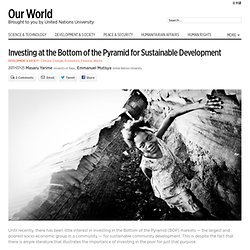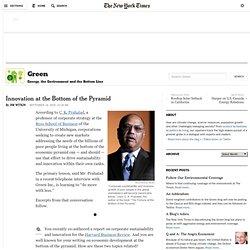

The market at the bottom of the pyramid. Med device makers eye bottom of pyramid. Reframing the Poverty Problem - Marketing can help address social ills. With billions of people living at the bottom of the income pyramid, some on less than $2.50 a day, the problem of poverty is as widespread as it is pressing. There are nearly as many plans to tackle poverty as there are charitable organizations addressing the problem. But one of the latest is so vastly different that is has some real possibility: What if poverty could be approached as a marketing opportunity rather than a social problem? Bobby Calder and his colleagues argue that it should. “Companies often approach issues like poverty as social problems more than as marketing opportunities,” says Calder, a professor of marketing at the Kellogg School of Management, “but the so-called bottom of the pyramid provides a vast marketing opportunity for innovative, socially-minded companies.” Over the past decade, many companies have taken a stand to address social problems such as poverty.
Participants in Patrimonio Hoy pay about $14 a week for seventy weeks. Related content: New Approaches to New Markets: How C.K. Prahalad's Bottom of the Pyramid Strategies Are Paying Off. Five years ago, C.K.

Prahalad published a book titled, The Fortune at the Bottom of the Pyramid, in which he argues that multinational companies not only can make money selling to the world’s poorest, but also that undertaking such efforts is necessary as a way to close the growing gap between rich and poor countries. Key to his argument for targeting the world’s poorest is the sheer size of that market — an estimated four billion people. How has Prahalad’s book — a revised, fifth-anniversary edition of which has just been published — affected the behavior of companies and the well-being of consumers in the years since its publication? Knowledge@Wharton checked in with the author for an update, including examples of specific companies that are implementing Bottom of the Pyramid strategies.
Below is an edited transcript of the conversation. C.K. Scraping bottom of the pyramid. UCI IMTFI Institute for Money, Technology, and Financial Inclusion. Bendell, Jem.

From Responsibility to Opportunity: CSR and the Future of Corporate Contributions to World Development MHCi MONTHLY FEATURE: Abstract: Bendell’s article offers four critiques of the “Bottom of the Pyramid”: First, we have to query whether the evidence of profitable business with low income markets is really evidence of engaging those in poverty. There is a great diversity of incomes within the group of 4 billion people that are often referred to. Cell phones and IT may have multiplier effects on an economy, by facilitating more electronic payments and access to financial instruments for some people, but it is not clear how this benefits the malnourished and those without clean water. The argument that wealth will 'trickle down' does not correspond with the experience of many countries, where economic development has led to wealth gushing up to the rich few. Abstract: Prahalad’s thesis is extremely vague, indeed it identifies seven versions.
Gordon, Michael D. 2008. Bottom Of Pyramid Changed Business Models In India. Investing at the Bottom of the Pyramid for sustainable development. Until recently, there has been little interest in investing in the Bottom of the Pyramid (BOP) markets — the largest and poorest socio-economic group in a community — for sustainable community development.

This is despite the fact that there is ample literature that illustrates the importance of investing in the poor for just that purpose. There is, however, little practical orientation in academic texts regarding the fast increasing gap between the rich and poor in developing countries. Current research is enormously concerned with institutional returns from BOP markets and has very little practical focus on the nexus between sustainable community development and applicable investment models. One established approach is the provision of financial services to the poor in order to promote micro enterprises for poverty alleviation. In this model, a bank unit is set up with a Field Manager and a number of bank workers, covering an area of about 15 to 22 villages. Nairobi’s Kibera slum. Innovation at the Bottom of the Pyramid. Bloomberg News“Corporate sustainability and inclusive growth of poor people in the global marketplace will become inextricably linked,” says C.

Globalization's Effects on the Global Poor - C. K. Prahalad. C.K. Prahalad.